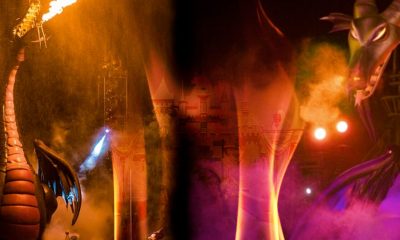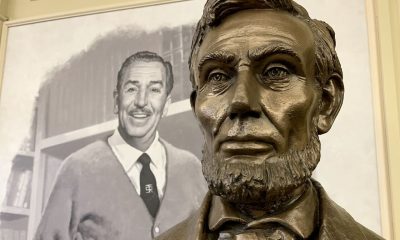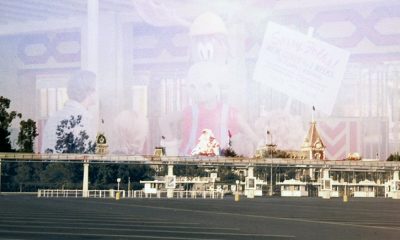History
Steam Trains & World’s Fair Attractions: Speed of Construction at Disneyland in the 1960s
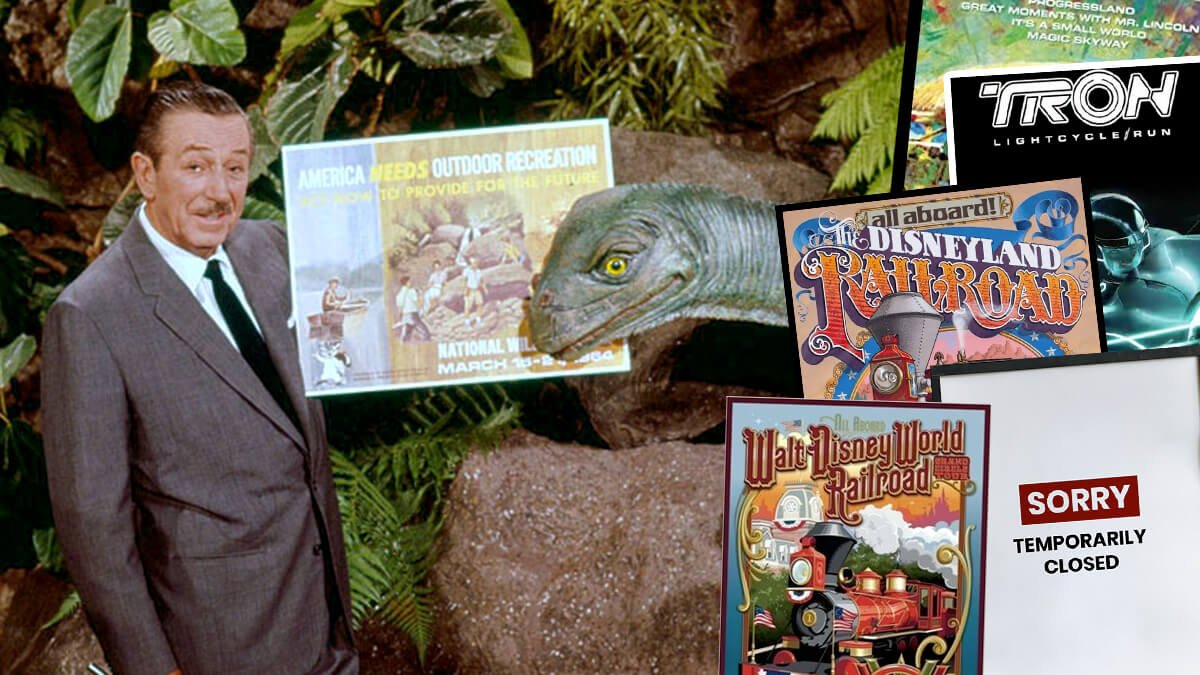
Steam train fans rejoiced in May 2022 when photos appeared online showing crews prepping the rail bed for the Walt Disney World Railroad. This Magic Kingdom favorite was temporarily shut down in early December of 2018 so that site prep could then begin for Tomorrowland’s next thrill ride, TRON Lightcycle Run.
Three years and 5 months later (which – let’s be honest here – is a pretty relaxed definition of “temporarily”), what with the rail bed being regraded … It’s only a matter of time before the ties that the rails sit on get put in place. Which means that we’re only months out from the Walt Disney World Railroad once again making a Grand Circle Tour of the Magic Kingdom. 20-minute-long experience / rolling along 1.5 miles worth of track.
Early Disneyland Attraction Downtime and Maintenance
I have to say that Walt himself wouldn’t have tolerated the idea of Disney World’s steam train being out of commission for 3 & a ½ years while a single attraction was added to the Magic Kingdom. He could barely tolerate it back in late 1965 / early 1966 when Disneyland’s railroad had to be shut down for a few months so that FOUR new attractions could added to “The Happiest Place on Earth.”
Mind you, Walt had an advantage in Anaheim back in the Fall of 1965 / Spring of 1966 that the folks who operate the Disney theme parks in Florida never got to enjoy. Which was — for much of the first 30 years Disneyland Park was in operation – that theme park was closed on Mondays & Tuesdays during the slow season. Which was the early Fall and late Winter months.
Which meant that – during those two-days-a-week the theme park-going public wasn’t wandering around the Happiest Place on Earth, getting underfoot – construction teams could get a crazy amount of work done.
More to the point: This was right after “Mary Poppins” had first opened in theaters (Its Hollywood premiere was held in late August of 1964, with the film itself going into wide release just three weeks later). And given that this Walt Disney Productions release would go on to be the highest grossing film of 1964 … Well, Walt now had a money fire hose in his hand and wasn’t afraid to use it.
World’s Fair Attractions Moved to Disneyland
So the first season of the 1964 – 1965 New York World’s Fair ends on October 18, 1964. Walt immediately has the Lincoln animatronic pulled out of the Illinois pavilion and brought back to Glendale. Where the Imagineers not only build a brand-new version of Honest Abe (one that will then address all of the operational issues that this Audio Animatronic had during its first year in Flushing Meadow where it was then constantly dealing with the Fair’s flukey electrical system), they built a second animatronic Lincoln.
Which is how the “Great Moments with Mr. Lincoln” show was able to open in the Main Street Opera House on July 18, 1965 (just as Disneyland was celebrating its tencennial. As in: The 10th anniversary of the Park’s opening to the public).
Changing Disneyland’s Anniversary
Interesting side note: While Walt was still alive, Disney’s anniversary of Disneyland’s opening was always celebrated on July 18th (which was when the public was first allowed into that family fun park). After Walt died in December of 1966, the date of the celebration of the anniversary of the opening of Disneyland Park eventually got shifted one day forward to July 17th. Because – if the Company used that date instead of July 18th – it then became possible to reshow that 90 minute-long “Dateline: Disneyland” special that aired live on ABC. Not to mention share all of those pictures of celebrities who visited the Park on July 17, 1955.
Disney’s done the same thing in the past. Mickey Mouse’s birthday used to be October 1st. Walt Disney himself – back in 1933 – announced that was the Mouse’s birthdate. But in 1978, then-Disney archivist Dave Smith issued a correction. Given that Mickey’s first cartoon with synchronized sound – “Steamboat Willie” – debuted at New York City’s Colonial Theatre on November 18, 1928 … Well, from that point forward, November 18th would be considered Mickey’s birthday.
Long story short: To borrow a phrase from “Doctor Who,” when it comes to the timey-wimey aspects of Disney Company history, things can get a little slippy-slidey.
Moving “it’s a small world” to Disneyland
Getting back to Walt and his money fire hose … While the New York World’s Fair was shut down for the Winter between October 1964 and April of 1967, Walt had the 27 technicians that he’d sent out from Disney Studios out to New York to keep all of the shows that the Imagineers had built for the Fair up & running … Well, Walt first had these folks retool the load / unload area for “it’s a small world.”
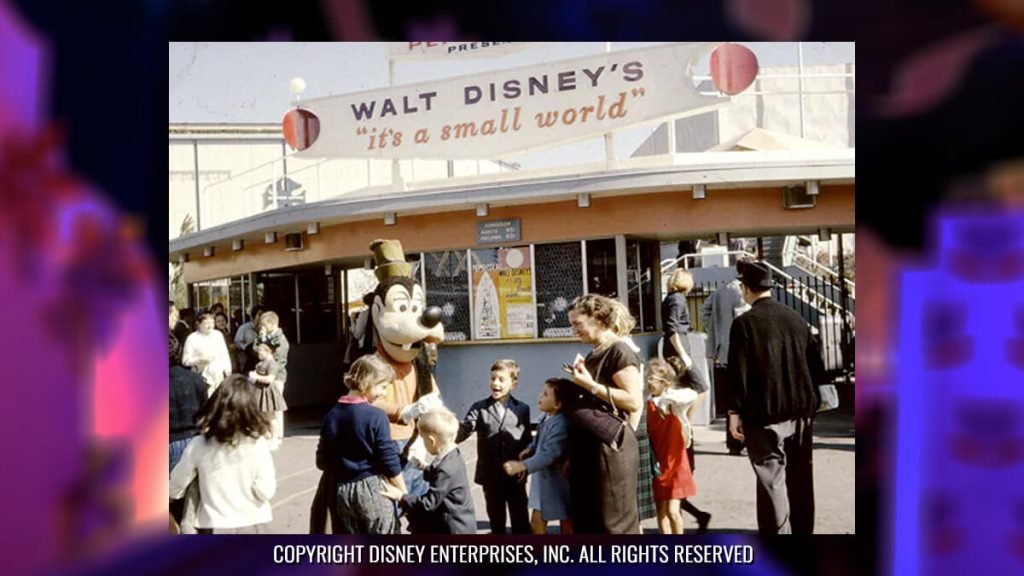
That sponsored-by-Pepsi-Cola attraction was a people-eating machine. On average, 4500 people a hour were able to experience “The Happiest Voyage That Ever Sailed.” Which meant that 80% of the people who went to the New York World’s Fair in 1964 & 1965 were able to experience “Small World.”
But Walt thought that they could do even better. Which is why – during the off-season – he had the Imagineers reworked that attraction’s load/ unload area so that it could be even more efficient. With the goal of getting an additional 500 people an hour through “it’s a small world.”
World’s Fair Closing and Final Move
Of course, once the New York World’s Fair closed for good on October 17, 1965, the race was on. The Imagineers partnered with the Mayflower Moving Company to get all of those sets & animatronic figures packed up as quickly as possible and then set back to Glendale for refurbishment. That’s what happened to the 32 animatronic figures in “General Electric’s Progressland” pavilion. Likewise all of the mechanical dinosaurs that used to menace fairgoers as they rolled through “Ford’s Magic Skyway.”
Now the genuinely crazy part of this story is that – just seven months later – the Disneyland versions of these New York World’s Fair shows began to open in Anaheim. “it’s a small world” opened on the West Coast on May 28, 1966. And this wasn’t just the exact same show that had played in Flushing Meadow for the past two years. Walt insisted that it be plussed & improved prior to installation. Which is how the Anaheim edition of “it’s a small world” wound up with two additional scenes – the Pacific Islands and the North Pole.

“The Primeval World” Diorama
And just a month or so after that, “The Primeval World” – which, at that time, the Company’s PR team described as “ … the world’s largest diorama featuring life-like recreations of some of the largest creatures to ever roam our planet” – opened on July 1, 1966.
Now what’s kind of intriguing about the “Primeval World” diorama is what’s to either side of this structure. Which is the old Disneyland administration building. This three story structure – which was also built in late 1965 / early 1966 as part of what was then supposed to be the biggest building program in Disneyland history – was built in such a way that half of this 450 foot-long structure was built on the outside of the berm and the other half of this 450 foot-long structure was built on the inside of the berm. With the structure that the Disneyland steam train passed through, that lengthy glassed-in room full of animatronic dinosaurs then serving as … Well, if you think of Disneyland’s new Admin building as an enormous Oreo, the “Primeval World” diorama then served as this 100,000 square foot structure’s creamy center.
Kind of a funny side story here. Everyone who worked in the 200 offices who were housed in Disneyland’s new Admin building would tell the same story. How – for the first few days you worked in this three story tall structure – you couldn’t help but notice how the Admin building would rumble as the steam train passed through the giant diorama in the middle of that structure. Or – for that matter – how the roar of the mechanical dinosaurs below would endlessly faintly echo center through the building as long as that ride was running.
Conversely though, after a few days of working in the Disneyland admin building, the rumble of the steam train and the roar of the dinosaurs just became white noise. That’s how you’d then know if you were dealing with a new hire at the Park. If someone who had just been assigned to the Admin building would then turn to you and say “What is that noise?” And – as a Company vet – you could then say “Oh, yeah. About that.”
“…a Disneyland without its steam trains just isn’t worth the full price of admission.”
Getting back to all of the construction that was going on at Disneyland in late 1965 / early 1966 … You have to remember that – if we’re talking about “Pirates of the Caribbean” and “it’s a small world” – we’re talking about two attractions with huge show buildings that were built outside of the theme park. Which meant – in order for these two boat-powered rides to take Guests under the berm and then out to their main show buildings and then back into the Park to their off-load areas … That meant digging a passage under the track bed of the Disneyland Railroad. Several passages, actually.
But again, because the steam train at Disneyland was Walt’s personal property at this time (along with the Mark Twain steamboat AND the Alweg Monorail), Walt just wouldn’t tolerate the idea that the steam train at the park would be shut down for a year or more to allow construction of these four new major attractions. As Disneyland’s tencennial celebration began to wind down in the late Summer / early Fall of 1965, Walt turned to the Imagineers and said “I’ll give you five months. Figure it out.”
Mind you, Walt reportedly got furious with the Imagineers when – due to the enormous construction challenges this $23 million project entailed — …
… That – by the way – is what it cost to building the Disneyland version of “it’s a small world,” New Orleans Square, Pirates of the Caribbean, Primeval World AND the Park’s new administration building. Just $23 million total .
… Anyway, Walt reportedly got furious when – due to a very wet Spring (By the way, that Albert Hammond song from 1972 – “It Never Rains in Southern California” – lies through its teeth) – work on getting the Disneyland Railroad fell behind schedule by one entire month.

John Hench once told me about how – when they had to tell Walt that the opening of Disneyland’s railroad would be delayed by a full month in the Spring of 1966 – he’d never seen his boss so mad. Walt reportedly went on & on about how a Disney theme park without a steam train wasn’t worth the price that they were then charging people to get into Disneyland (a then-whopping $5.00 for adults, $4.50 for juniors – ages 12 – 17 – and $4.00 for kids 3 – 11. That would have gotten you the park’s Deluxe 15 Ticket book). Walt reportedly turned to John and said “If people ask, we’re going to have to agree to issue them a refund. Because a Disneyland without its steam trains just isn’t worth the full price of admission.”
I wonder what would happen if someone today went into City Hall at WDW’s Magic Kingdom and shared that story from the Spring of 1966. What a Cast Member who was working in Guest Relations at that theme park would have to say in response.
Walt Disney World Railroad Downtime
I mean, I get that it’s not their fault that the Walt Disney World Railroad has been out of commission since December of 2018. And we also have to acknowledge that much of the Resort was shuttered for months in 2020 during the early days of the pandemic.
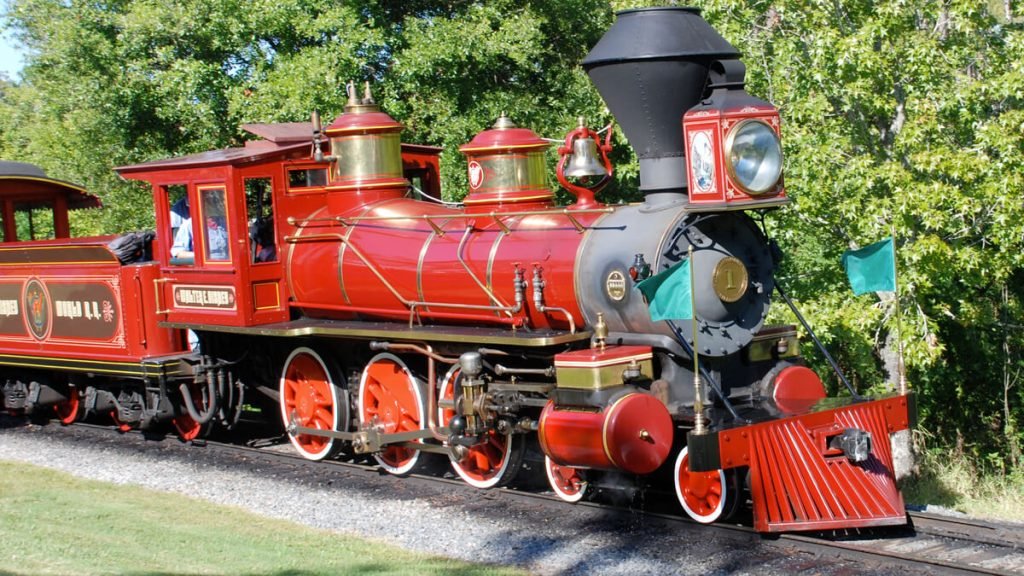
But even so, at a time when the Florida parks are continually struggling to keep the rides, shows & attractions that they already have up & running on a reliable, regular basis, to have a people eater like the Magic Kingdom’s steam trains shut down for 3 & a half years … That’s just inexcusable.
This article is based on research for The Disney Dish Podcast “Episode 377”, published on June 6, 2022. The Disney Dish Podcast is part of the Jim Hill Media Podcast Network.
History
The Evolution and History of Mickey’s ToonTown

Disneyland in Anaheim, California, holds a special place in the hearts of Disney fans worldwide, I mean heck, it’s where the magic began after all. Over the years it’s become a place that people visit in search of memorable experiences. One fan favorite area of the park is Mickey’s Toontown, a unique land that lets guests step right into the colorful, “Toony” world of Disney animation. With the recent reimagining of the land and the introduction of Micky and Minnies Runaway Railway, have you ever wondered how this land came to be?
There is a fascinating backstory of how Mickey’s Toontown came into existence. It’s a tale of strategic vision, the influence of Disney executives, and a commitment to meeting the needs of Disney’s valued guests.
The Beginning: Mickey’s Birthdayland
The story of Mickey’s Toontown starts with Mickey’s Birthdayland at Walt Disney World’s Magic Kingdom. Opened in 1988 to celebrate Mickey Mouse’s 60th birthday, this temporary attraction was met with such overwhelming popularity that it inspired Disney executives to think bigger. The idea was to create a permanent, immersive land where guests could step into the animated world of Mickey Mouse and his friends.
In the early ’90s, Disneyland was in need of a refresh. Michael Eisner, the visionary leader of The Walt Disney Company at the time, had an audacious idea: create a brand-new land in Disneyland that would celebrate Disney characters in a whole new way. This was the birth of Mickey’s Toontown.
Initially, Disney’s creative minds toyed with various concepts, including the idea of crafting a 100-Acre Woods or a land inspired by the Muppets. However, the turning point came when they considered the success of “Who Framed Roger Rabbit.” This film’s popularity and the desire to capitalize on contemporary trends set the stage for Toontown’s creation.
From Concept to Reality: The Birth of Toontown
In 1993, Mickey’s Toontown opened its gates at Disneyland, marking the first time in Disney Park history where guests could experience a fully realized, three-dimensional world of animation. This new land was not just a collection of attractions but a living, breathing community where Disney characters “lived,” worked, and played.
Building Challenges: Innovative Solutions
The design of Mickey’s Toontown broke new ground in theme park aesthetics. Imagineers were tasked with bringing the two-dimensional world of cartoons into a three-dimensional space. This led to the creation of over 2000 custom-built props and structures that embodied the ‘squash and stretch’ principle of animation, giving Toontown its distinctiveness.
And then there was also the challenge of hiding the Team Disney Anaheim building, which bore a striking resemblance to a giant hotdog. The Imagineers had to think creatively, using balloon tests and imaginative landscaping to seamlessly integrate Toontown into the larger park.

Key Attractions: Bringing Animation to Life
Mickey’s Toontown featured several groundbreaking attractions. “Roger Rabbit’s Car Toon Spin,” inspired by the movie “Who Framed Roger Rabbit,” became a staple of Toontown, offering an innovative ride experience. Gadget’s Go-Coaster, though initially conceived as a Rescue Rangers-themed ride, became a hit with younger visitors, proving that innovative design could create memorable experiences for all ages.
Another crown jewel of Toontown is Mickey’s House, a walkthrough attraction that allowed guests to explore the home of Mickey Mouse himself. This attraction was more than just a house; it was a carefully crafted piece of Disney lore. The house was designed in the American Craftsman style, reflecting the era when Mickey would have theoretically purchased his first home in Hollywood. The attention to detail was meticulous, with over 2000 hand-crafted, custom-built props, ensuring that every corner of the house was brimming with character and charm. Interestingly, the design of Mickey’s House was inspired by a real home in Wichita Falls, making it a unique blend of real-world inspiration and Disney magic.
Mickey’s House also showcased Disney’s commitment to creating interactive and engaging experiences. Guests could make themselves at home, sitting in Mickey’s chair, listening to the radio, and exploring the many mementos and references to Mickey’s animated adventures throughout the years. This approach to attraction design – where storytelling and interactivity merged seamlessly – was a defining characteristic of ToonTown’s success.

Executive Decisions: Shaping ToonTown’s Unique Attractions
The development of Mickey’s Toontown wasn’t just about creative imagination; it was significantly influenced by strategic decisions from Disney executives. One notable input came from Jeffrey Katzenberg, who suggested incorporating a Rescue Rangers-themed ride. This idea was a reflection of the broader Disney strategy to integrate popular contemporary characters and themes into the park, ensuring that the attractions remained relevant and engaging for visitors.
In addition to Katzenberg’s influence, Frank Wells, the then-President of The Walt Disney Company, played a key role in the strategic launch of Toontown’s attractions. His decision to delay the opening of “Roger Rabbit’s Car Toon Spin” until a year after Toontown’s debut was a calculated move. It was designed to maintain public interest in the park by offering new experiences over time, thereby giving guests more reasons to return to Disneyland.
These executive decisions highlight the careful planning and foresight that went into making Toontown a dynamic and continuously appealing part of Disneyland. By integrating current trends and strategically planning the rollout of attractions, Disney executives ensured that Toontown would not only capture the hearts of visitors upon its opening but would continue to draw them back for new experiences in the years to follow.
Global Influence: Toontown’s Worldwide Appeal
The concept of Mickey’s Toontown resonated so strongly that it was replicated at Tokyo Disneyland and influenced elements in Disneyland Paris and Hong Kong Disneyland. Each park’s version of Toontown maintained the core essence of the original while adapting to its cultural and logistical environment.
Evolution and Reimagining: Toontown Today
As we approach the present day, Mickey’s Toontown has recently undergone a significant reimagining to welcome “Mickey & Minnie’s Runaway Railway” in 2023. This refurbishment aimed to enhance the land’s interactivity and appeal to a new generation of Disney fans, all while retaining the charm that has made ToonTown a beloved destination for nearly three decades.

Dive Deeper into ToonTown’s Story
Want to know more about Mickey’s Toontown and hear some fascinating behind-the-scenes stories, then check out the latest episode of Disney Unpacked on Patreon @JimHillMedia. In this episode, the main Imagineer who worked on the Toontown project shares lots of interesting stories and details that you can’t find anywhere else. It’s full of great information and fun facts, so be sure to give it a listen!
History
Unpacking the History of the Pixar Place Hotel

Pixar Place Hotel, the newly unveiled 15-story tower at the Disneyland Resort, has been making waves in the Disney community. With its unique Pixar-themed design, it promises to be a favorite among visitors.
However, before we delve into this exciting addition to the Disneyland Resort, let’s take a look at the fascinating history of this remarkable hotel.
The Emergence of the Disneyland Hotel
To truly appreciate the story of the Pixar Place Hotel, we must turn back the clock to the early days of Disneyland. While Walt Disney had the visionary ideas and funding to create the iconic theme park, he faced a challenge when it came to providing accommodations for the park’s visitors. This is where his friend Jack Wrather enters the picture.
Jack Wrather, a fellow pioneer in the television industry, stepped in to assist Walt Disney in realizing his dream. Thanks to the success of the “Lassie” TV show produced by Wrather’s company, he had the financial means to build a hotel right across from Disneyland.
The result was the Disneyland Hotel, which opened its doors in October 1955. Interestingly, the early incarnation of this hotel had more of a motel feel than a hotel, with two-story buildings reminiscent of the roadside motels popular during the 1950s. The initial Disneyland Hotel consisted of modest structures that catered to visitors looking for affordable lodging close to the park. While the rooms were basic, it marked the beginning of something extraordinary.
The Evolution: From Emerald of Anaheim to Paradise Pier
As Disneyland’s popularity continued to soar, so did the demand for expansion and improved accommodations. In 1962, the addition of an 11-story tower transformed the Disneyland Hotel, marking a significant transition from a motel to a full-fledged hotel.
The addition of the 11-story tower elevated the Disneyland Hotel into a more prominent presence on the Anaheim skyline. At the time, it was the tallest structure in all of Orange County. The hotel’s prime location across from Disneyland made it an ideal choice for visitors. With the introduction of the monorail linking the park and the hotel, accessibility became even more convenient. Unique features like the Japanese-themed reflecting pools added to the hotel’s charm, reflecting a cultural influence that extended beyond Disney’s borders.
Japanese Tourism and Its Impact
During the 1960s and 1970s, Disneyland was attracting visitors from all corners of the world, including Japan. A significant number of Japanese tourists flocked to Anaheim to experience Walt Disney’s creation. To cater to this growing market, it wasn’t just the Disneyland Hotel that aimed to capture the attention of Japanese tourists. The Japanese Village in Buena Park, inspired by a similar attraction in Nara, Japan, was another significant spot.
These attractions sought to provide a taste of Japanese culture and hospitality, showcasing elements like tea ceremonies and beautiful ponds with rare carp and black swans. However, the Japanese Village closed its doors in 1975, likely due to the highly competitive nature of the Southern California tourist market.
The Emergence of the Emerald of Anaheim
With the surge in Japanese tourism, an opportunity arose—the construction of the Emerald of Anaheim, later known as the Disneyland Pacific Hotel. In May 1984, this 15-story hotel opened its doors.
What made the Emerald unique was its ownership. It was built not by The Walt Disney Company or the Oriental Land Company (which operated Tokyo Disneyland) but by the Tokyu Group. This group of Japanese businessmen already had a pair of hotels in Hawaii and saw potential in Anaheim’s proximity to Disneyland. Thus, they decided to embark on this new venture, specifically designed to cater to Japanese tourists looking to experience Southern California.
Financial Challenges and a Changing Landscape
The late 1980s brought about two significant financial crises in Japan—the crash of the NIKKEI stock market and the collapse of the Japanese real estate market. These crises had far-reaching effects, causing Japanese tourists to postpone or cancel their trips to the United States. As a result, reservations at the Emerald of Anaheim dwindled.
To adapt to these challenging times, the Tokyu Group merged the Emerald brand with its Pacific hotel chain, attempting to weather the storm. However, the financial turmoil took its toll on the Emerald, and changes were imminent.
The Transition to the Disneyland Pacific Hotel
In 1995, The Walt Disney Company took a significant step by purchasing the hotel formerly known as the Emerald of Anaheim for $35 million. This acquisition marked a change in the hotel’s fortunes. With Disney now in control, the hotel underwent a name change, becoming the Disneyland Pacific Hotel.
Transformation to Paradise Pier
The next phase of transformation occurred when Disney decided to rebrand the hotel as Paradise Pier Hotel. This decision aligned with Disney’s broader vision for the Disneyland Resort.
While the structural changes were limited, the hotel underwent a significant cosmetic makeover. Its exterior was painted to complement the color scheme of Paradise Pier, and wave-shaped crenellations adorned the rooftop, creating an illusion of seaside charm. This transformation was Disney’s attempt to seamlessly integrate the hotel into the Paradise Pier theme of Disney’s California Adventure Park.
Looking Beyond Paradise Pier: The Shift to Pixar Place
In 2018, Disneyland Resort rebranded Paradise Pier as Pixar Pier, a thematic area dedicated to celebrating the beloved characters and stories from Pixar Animation Studios. As a part of this transition, it became evident that the hotel formally known as the Disneyland Pacific Hotel could no longer maintain its Paradise Pier theme.
With Pixar Pier in full swing and two successful Pixar-themed hotels (Toy Story Hotels in Shanghai Disneyland and Tokyo Disneyland), Disney decided to embark on a new venture—a hotel that would celebrate the vast world of Pixar. The result is Pixar Place Hotel, a 15-story tower that embraces the characters and stories from multiple Pixar movies and shorts. This fully Pixar-themed hotel is a first of its kind in the United States.
The Future of Pixar Place and Disneyland Resort
As we look ahead to the future, the Disneyland Resort continues to evolve. The recent news of a proposed $1.9 billion expansion as part of the Disneyland Forward project indicates that the area surrounding Pixar Place is expected to see further changes. Disneyland’s rich history and innovative spirit continue to shape its destiny.
In conclusion, the history of the Pixar Place Hotel is a testament to the ever-changing landscape of Disneyland Resort. From its humble beginnings as the Disneyland Hotel to its transformation into the fully Pixar-themed Pixar Place Hotel, this establishment has undergone several iterations. As Disneyland Resort continues to grow and adapt, we can only imagine what exciting developments lie ahead for this iconic destination.
If you want to hear more stories about the History of the Pixar Place hotel, check our special edition of Disney Unpacked over on YouTube.
Stay tuned for more updates and developments as we continue to explore the fascinating world of Disney, one story at a time.
History
From Birthday Wishes to Toontown Dreams: How Toontown Came to Be

In the latest release of Episode 4 of Disney Unpacked, Len and I return, joined as always by Disney Imagineering legend, Jim Shull. This two-part episode covers all things Mickey’s Birthday Land and how it ultimately led to the inspiration behind Disneyland’s fan-favorite land, “Toontown”. But let’s not get ahead of ourselves here. It all starts in the early days at Disneyland.
Early Challenges in Meeting Mickey
Picture this: it’s the late 1970s and early 1980s, and you’re at Disneyland. You want to meet the one and only Mickey Mouse, but there’s no clear way to make it happen. You rely on Character Guides, those daily printed sheets that point you in Mickey’s general direction. But let’s be honest, it was like finding a needle in a haystack. Sometimes, you got lucky; other times, not so much.

Mickey’s Birthdayland: A Birthday Wish that Came True
Fast forward to the late 1980s. Disney World faced a big challenge. The Disney-MGM Studios Theme Park was under construction, with the company’s marketing machine in full swing, hyping up the opening of Walt Disney World’s third theme park, MGM Studios, in the Spring of 1989. This extensive marketing meant that many people were opting to postpone their family’s next trip to Walt Disney World until the following year. Walt Disney World needed something compelling to motivate guests to visit Florida in 1988, the year before Disney MGM Studios opened.
Enter stage left, Mickey’s Birthdayland. For the first time ever, an entire land was dedicated to a single character – and not just any character, but the mouse who started it all. Meeting Mickey was no longer a game of chance; it was practically guaranteed.

The Birth of Birthdayland: Creative Brilliance Meets Practicality
In this episode, we dissect the birth of Mickey’s Birthdayland, an initiative that went beyond celebrating a birthday. It was a calculated move, driven by guest feedback and a need to address issues dating back to 1971. Imagineers faced the monumental task of designing an experience that honored Mickey while efficiently managing the crowds. This required the perfect blend of creative flair and logistical prowess – a hallmark of Disney’s approach to theme park design.
Evolution: From Birthdayland to Toontown
The success of Mickey’s Birthdayland was a real game-changer, setting the stage for the birth of Toontown – an entire land that elevated character-centric areas to monumental new heights. Toontown wasn’t merely a spot to meet characters; it was an immersive experience that brought Disney animation to life. In the episode, we explore its innovative designs, playful architecture, and how every nook and cranny tells a story.

Impact on Disney Parks and Guests
Mickey’s Birthdayland and Toontown didn’t just reshape the physical landscape of Disney parks; they transformed the very essence of the guest experience. These lands introduced groundbreaking ways for visitors to connect with their beloved characters, making their Disney vacations even more unforgettable.
Beyond Attractions: A Cultural Influence
But the influence of these lands goes beyond mere attractions. Our episode delves into how Mickey’s Birthdayland and Toontown left an indelible mark on Disney’s culture, reflecting the company’s relentless dedication to innovation and guest satisfaction. It’s a journey into how a single idea can grow into a cherished cornerstone of the Disney Park experience.

Unwrapping the Full Story of Mickey’s Birthdayland
Our two-part episode of Disney Unpacked is available for your viewing pleasure on our Patreon page. And for those seeking a quicker Disney fix, we’ve got a condensed version waiting for you on our YouTube channel. Thank you for being a part of our Disney Unpacked community. Stay tuned for more episodes as we continue to “Unpack” the fascinating world of Disney, one story at a time.
-

 History10 months ago
History10 months agoThe Evolution and History of Mickey’s ToonTown
-

 History11 months ago
History11 months agoUnpacking the History of the Pixar Place Hotel
-

 History11 months ago
History11 months agoFrom Birthday Wishes to Toontown Dreams: How Toontown Came to Be
-

 Film & Movies8 months ago
Film & Movies8 months agoHow Disney’s “Bambi” led to the creation of Smokey Bear
-

 News & Press Releases10 months ago
News & Press Releases10 months agoNew Updates and Exclusive Content from Jim Hill Media: Disney, Universal, and More
-

 Merchandise8 months ago
Merchandise8 months agoIntroducing “I Want That Too” – The Ultimate Disney Merchandise Podcast
-

 Theme Parks & Themed Entertainment3 months ago
Theme Parks & Themed Entertainment3 months agoDisney’s Forgotten Halloween Event: The Original Little Monsters on Main Street
-

 Film & Movies3 months ago
Film & Movies3 months agoHow “An American Tail” Led to Disney’s “Hocus Pocus”





